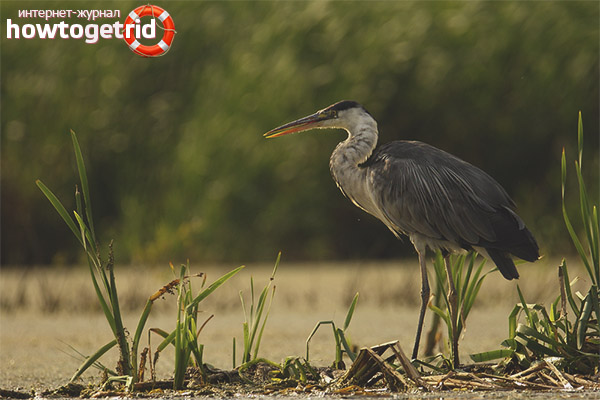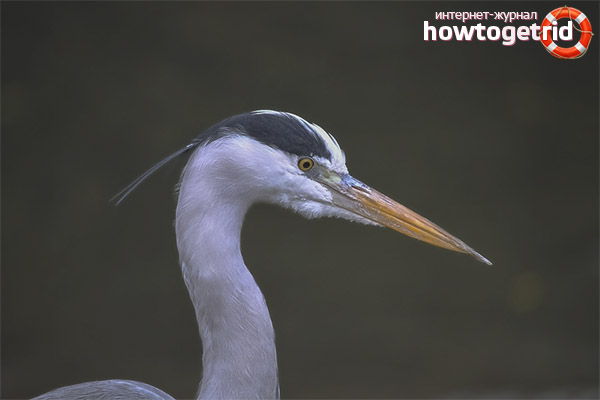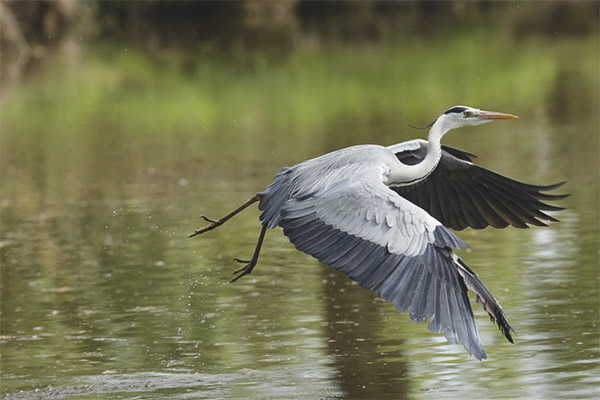The content of the article
The gray heron belongs to the order of ciconiiformes. The peculiarity of the appearance of this bird is that its neck is very long, as well as its limbs. In a gray heron the body is covered with gray plumage from above, and at the bottom it is white. In the coloring there are black specks. The beak of this species is long and sharp. Bird refers to large. Adults weigh up to 2 kg. On the continents of Eurasia and Africa there are very many of these birds.
Description
The neck of a heron is long, as are its beak and legs. It can weigh one and a half kilograms and more. The body in length is about 1 m, and the wingspan is one and a half meters or more. The beak is cone-shaped.
The body on top has a gray-gray color, and on the belly and breast - lighter. The head of a heron is white. In the area above the eyes there are dark stripes. On the back of their heads, they converge.The long neck of the bird is light gray, covered with small black spots. The primary wings are black, and the rest are gray-gray. On the chest feathers are long. During the mating season, they lengthen even more. On the sides are wide stripes of black. And the bird's tail is gray.
Nutrition
During the hunt, the bird can just stand still and wait until it gets prey. Sometimes she goes from side to side in search of the victim. Having seen suitable prey, the heron very quickly straightens its long neck, and catches it. When it is caught, the bird swallows its victim entirely. Sometimes the heron does not hunt on its own, but steals food from other birds of prey, such as cormorants or gulls. But, in turn, the herons themselves can be left without lunch, as they are sometimes taken by the crows.
The bird can fly far to get food. It flies over a distance of 0.5 to 30 km.
Habitat
In Eurasia, this bird is very widespread. She does not live only in the desert and in the mountains at high altitude. They also live in southeast Asia. In the south, the gray heron habitat extends to the Mediterranean Sea. Representatives of the species can be found in some areas of the African continent. They live in the southern and eastern parts of the country, in Madagascar and the Maldives.
High in the mountains this bird can not be found. The maximum height at which they fly is 1000 m. They live near fresh water bodies, sometimes near seas or lakes with salt water. Hunting bird in shallow water.
Representatives of the species who live in the center and in the south of Europe constantly live on the same territory, only occasionally flying to more southern regions. Those individuals who live on the territory of modern Russia fly to warm Africa for the winter. And those populations, whose permanent habitat is the territory of Central Asia, fly to China, India.
What are the subspecies
Herons that live in different territories are divided into subspecies. We list the main ones.
- Ardea cinerea cinerea - this subspecies lives in Eurasia. Their habitat spreads from western Europe to the Trans-Urals.
- In Madagascar there are gray herons belonging to such a species as Ardea cinerea firasa.
- Ardea cinerea monicae - on the coast of Mauritania.
Sex differences
It is not easy to distinguish representatives of different sexes, even if they are viewed closely. But they differ in size. Therefore, if you meet two individuals of different sexes that are nearby, you can determine the sex. In males, the wing is longer - 46 cm, and the length of the beak usually exceeds 12 cm. In females, these parts of the body are shorter by several centimeters and more.
Breeding

Gray Heron is a monogamous bird species. This means that they form a pair and remain true throughout life. Already at the age of a year or two, individuals become sexually mature.
During the mating season, their beak acquires a brighter color, orange or pink. At other times it is gray. In addition, other parts of the body of the birds become brighter. It occurs in both sexes.
Herons that live in cold or temperate climates fly away for the winter.They return with a thaw, which occurs in the second half of March or early April. As soon as the birds return to their nesting sites after wintering, they begin to build the nest. Populations that live in warmer areas and do not migrate to winter, do not have any specific breeding season.
First, the male begins to equip the nest, and then - to call the female. This ritual in birds is very unusual. When a male gray heron calls for a female, he makes a croaking sound, while spreading his wings and pointing his beak upwards. The female comes to his cry, but the male does not let her, driving away from the nest. This happens several times. But, in this case, the later the female responds to the call, the sooner he will cease to chase her. If 2 weeks or more has passed since the beginning of the arrangement by the male of the nest, the pair will be formed immediately. After that, they complete the arrangement of the nest together.
Nest representatives of this species are placed on very tall trees or large bushes. The material are twigs, twigs and reed stem. The nest is conical in shape, flat, pointed downwards.Its diameter is 65-80 cm, and the height is about half a meter. Representatives of this species become attached to their nest. From year to year they return to the same place to produce offspring.
On average, the female lays about 5 eggs. But sometimes their number ranges from 3 to 9. They are blue and white spots. Eggs are often pointed from two sides. Every 2 days, the gray heron lays an egg. Hatching them begins as soon as the first appears. Eggs are hatched by each partner in turn.
After 27 days, the chicks hatch. They have no plumage and need the full care of their parents. Only a week later, the first feathers begin to appear. Three times a day, the gray heron belches food from its stomach, and feeds its young. But it often happens that not everyone gets food. This leads to the fact that older, stronger chicks can simply eat the younger ones. Sometimes they can just steal food from them.
When the age of chicks is approaching a month, they are trying to fly for the first time and start learning how to hunt. After another 2 months, individuals begin to live independently.
Bird voice

Representatives of this species make rough sounds that resemble a rattle. They seem to croak, but very low and short. Such a bird makes a sound during the flight. This loud cry is heard quite far away. By this scream, the bird's approach can be recognized much earlier than it will be in sight. When she is about to land, she makes a strong, sharp cry several times, which also resembles a rattle.
Heron can make other sounds. Most often they can be heard when the birds are in the colonies and not far from their nest, since individually they usually remain silent. The alarm signal, which is issued by the representative of the gray heron species, is a gaggle. When a bird shows aggression and expresses a threat, a prolonged vibrating cry is published.
Interesting Facts
- Representatives of the gray heron species have a special system of unique signals that allow them to communicate. The bird is able to express different emotions. The presence of a long neck helps her in this. When a bird is threatened, it arches its neck, as if it is about to rush forward. Tuft, located on the head, rises. This is followed by a scream.
- There is also a welcome signal. It manifests itself in the click of the beak when the bird sees its fellows. They also behave during the marriage ritual.
- The meat of this bird is quite possible to eat. Sometimes hunters shoot a heron to taste it. But according to reviews, it does not have a pleasant taste, so hunting for these birds is not very common.
- Previously, falconry was quite popular, the object of which was often chosen precisely gray heron.
Video: Gray Heron (Ardea cinerea)











To send